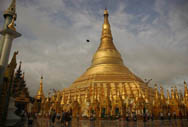| ||||
| ||||
 Aung San Suu Kyi is a name bigger than the nation itself and often the reason Myanmar stays in the news. Her release from detention last year brought mixed cheers as the military regime has been known to reverse their stance and detain her right back as has happened several times before. The nation’s further tentative steps towards opening up were also viewed with suspicion. But one year down the line, there seems no rolling back as Myanmar continues to shore up international confidence with ongoing voluntary reforms. US secretary of state Hillary Clinton’s recent visit seems emblematic of this growing confidence. So, are the winds of change for real this time?
Aung San Suu Kyi is a name bigger than the nation itself and often the reason Myanmar stays in the news. Her release from detention last year brought mixed cheers as the military regime has been known to reverse their stance and detain her right back as has happened several times before. The nation’s further tentative steps towards opening up were also viewed with suspicion. But one year down the line, there seems no rolling back as Myanmar continues to shore up international confidence with ongoing voluntary reforms. US secretary of state Hillary Clinton’s recent visit seems emblematic of this growing confidence. So, are the winds of change for real this time? Looking at its past, Burma (as it was then called) gained independence from the British colonial rule in 1948 and set out on a democratic path. The ensuing era was fraught with instability brought on by a series of political and ethnic insurrections as the nation is riven by 135 odd different ethnic communities. In 1962, there was a military coup and the junta regime came to power and has held on to it ever since. Being an authoritarian regime, Myanmar has faced harsh international sanctions, although it is not seen as such a villain in the region itself. Both India and China have maintained diplomatic as well as trade ties with it. But general political and economic isolation in an increasingly global world has hurt the nation and continued military dictatorship taken a toll on people’s spirit.
Perhaps realizing the inherent implausibility of its continued military rule, the regime started opening up starting with Suu Kyi’s release in Nov 2010. A civilian government was also instituted under Thein Sein who is widely considered as a moderate with a clean image. Several political prisoners have been released, dialogue initiated with separatist groups and media restrictions also relaxed, albeit only slightly. Aung San Suu Kyi is now allowed access to the international media as well as visitors and seems to be preparing to contest a parliamentary seat. This augurs wells for the nation as no doubt Suu Kyi is key to integrating Myanmar with the rest of the world. After decades of sacrifice and commitment, it is about time she be given her due political role in re crafting Myanmar’s future.
However, US urge for expediting reforms towards a full-fledged democracy may not be as pragmatic as it sounds on paper. If we look at a parallel here, in the early 1980s, Pakistan too went through a similar phase when the military rule was brought to a close and Benazir Bhutto, daughter of the slain leader, then an international favorite was seen as a new hope for the nation. Amidst huge popularity within the country and without, she was expected to usher in democracy and turn the country around. Democracy did come marching in full colors but the reality thereafter turned sour and things did not go as expected. This is often the fate of sudden political opening up and a turn to universal suffrage democracy in the developing world, Nepal being a recent victim of such an overhaul in the region. Factional power struggles and political opportunism take to the fore and rule of law as well as stability ironically suffer in a quest for the same.
Myanmar too has a potential for instability given the separatist movements that exist in its bordering regions as well as the drug mafia that continues to simmer despite some initiatives by the Junta. Instead of an abrupt and sudden break from the past, an evolutionary transition to democracy might be a far better option and seems to be the path Myanmar has thus far chosen for itself. Aung San Suu Kyi has a huge role to play in modernization and reintegration of Myanmar with the rest of the world. However instead of a shock therapy, which can endanger national stability, collaboration with the existing stakeholders and taking them along might be the best model for Myanmar. So long as the Junta backed leadership realizes this and continues moving forward with greater reforms, progressing even at the pace that they are, international bodies should perhaps play a more encouraging role. The much needed IMF and World Bank assistance as well as phased lifting of sanctions should be given a serious thought. They can always be rolled back should the nation backtrack on its path.
As of now the signals are positive that this time the change is for real and Myanmar is indeed set to take a break from its repressive past and step into the 21st century.